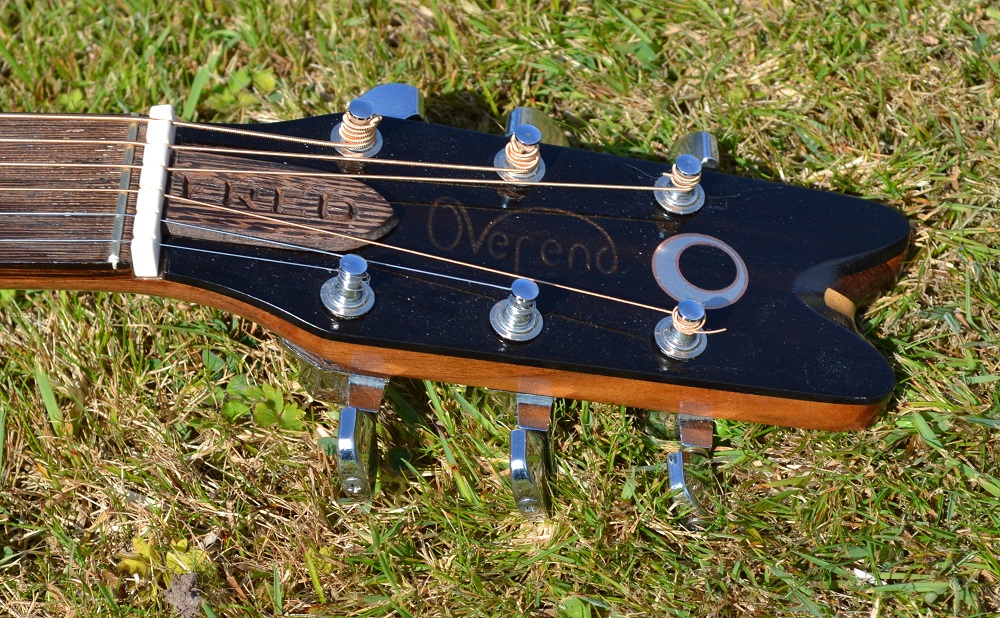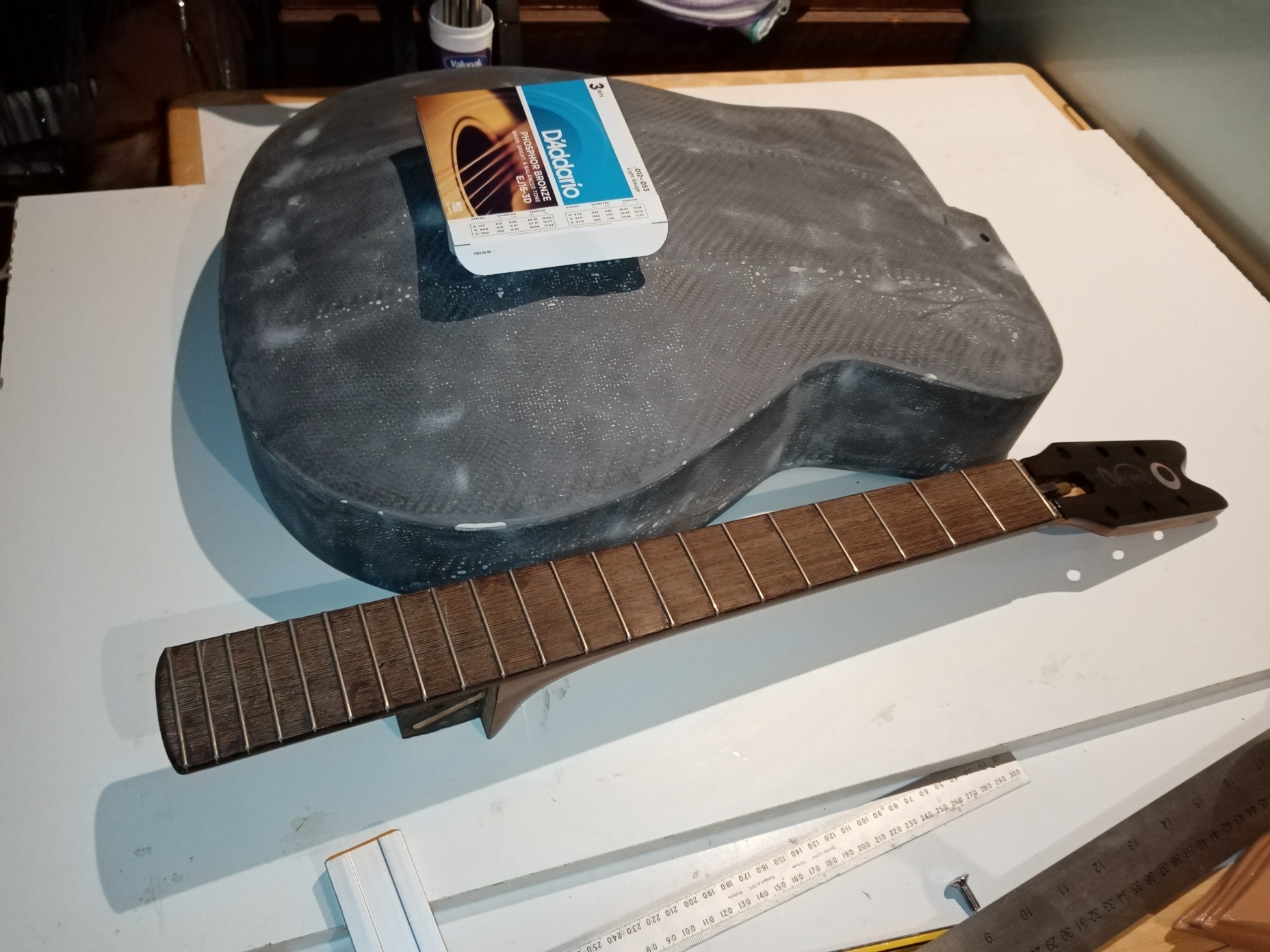Post by fred7 on Aug 4, 2021 15:40:08 GMT
Here is an odd guitar I have just finished and featured in the Plucky Duck (20 odd years after starting it). I don’t have many build process pics so these will have to do.
Back and sides – Bowled Carbon fibre which is very strong. As such there is no need for bracing on the back and the sides provide great stability for the soundboard.
Soundboard - Sitka Spruce with a traditional X bracing pattern (now).
Bridge - Aluminium and Wenge with bone saddle.
Neck - Five-piece laminate consisting of Walnut, Wenge and Maple 12/14 fret join
Fretboard – Wenge zero fret with compound 10” to 12” radius
Head veneer – Ebony
Nut width – 45mm
Scale length – 646mm
String spacing at bridge – 56mm
The aluminium string anchor is bolted through the top which gives a solid connection to the underside of the soundboard similar to pins whilst having the ease of changing strings on top. This also means the Wenge bridge and saddle only has pressure downwards onto the soundboard and no lateral twisting force trying to pull it away.
The shape is very close to Dreadnought with pinched waist









For this guitar, I wanted to try a more traditional 12 fret body but with a 14 fret access……. And it works for me.
It looks interesting? Quirky? Unusual? ….. or just stupid? You decide and don’t be afraid to say which. I could have just gone for a cutaway but I wanted it to look different (plus making the mould with cutaway would have been more work).
Guitar history (optional read):-
Around 1998 I started experimenting with an idea for a radical bracing system which needed a strong and stable back and sides. I made a crude mould and formed the carbon fibre body, then attached the braced soundboard and neck. On went the strings and whilst the sound was very loud, the tone was slightly lacking. Then I dropped it and broke the headstock. At the time I didn’t feel it worth working on further as the finish on the carbon fibre was not brilliant. It was strong enough but without a vacuum tank for the resin, it had tiny bubbles throughout which break through the surface whenever you fill and sand back. Meanwhile, my favourite guitar (which I made about 14 years ago) stays out on its’ stand and gets played every day and goes everywhere with me but is in desperate need of refurbishment. Rather than leave my Lowden out I thought I would get this guitar working so I could concentrate on the other at my leisure. I repaired the headstock and attacked the soundboard with the iron in an attempt to remove it from the body without damage. I then removed the bracing, and replaced with a more traditional ‘X’ brace pattern. The iron had messed up the finish on the front quite a lot so a lot of careful sanding to strip it back to the wood. Unfortunately the inlay and binding strip started to disappear in places so I had to stop sanding further. This is why the front appears slightly patchy in places but adds to the quirkiness of the guitar. I made the bridge from a piece of scrap Aluminium and put everything together and strung it up. I’m actually very pleased with the result but on close inspection it is in no danger of winning any prizes for a flawless finish.
Back and sides – Bowled Carbon fibre which is very strong. As such there is no need for bracing on the back and the sides provide great stability for the soundboard.
Soundboard - Sitka Spruce with a traditional X bracing pattern (now).
Bridge - Aluminium and Wenge with bone saddle.
Neck - Five-piece laminate consisting of Walnut, Wenge and Maple 12/14 fret join
Fretboard – Wenge zero fret with compound 10” to 12” radius
Head veneer – Ebony
Nut width – 45mm
Scale length – 646mm
String spacing at bridge – 56mm
The aluminium string anchor is bolted through the top which gives a solid connection to the underside of the soundboard similar to pins whilst having the ease of changing strings on top. This also means the Wenge bridge and saddle only has pressure downwards onto the soundboard and no lateral twisting force trying to pull it away.
The shape is very close to Dreadnought with pinched waist









For this guitar, I wanted to try a more traditional 12 fret body but with a 14 fret access……. And it works for me.
It looks interesting? Quirky? Unusual? ….. or just stupid? You decide and don’t be afraid to say which. I could have just gone for a cutaway but I wanted it to look different (plus making the mould with cutaway would have been more work).
Guitar history (optional read):-
Around 1998 I started experimenting with an idea for a radical bracing system which needed a strong and stable back and sides. I made a crude mould and formed the carbon fibre body, then attached the braced soundboard and neck. On went the strings and whilst the sound was very loud, the tone was slightly lacking. Then I dropped it and broke the headstock. At the time I didn’t feel it worth working on further as the finish on the carbon fibre was not brilliant. It was strong enough but without a vacuum tank for the resin, it had tiny bubbles throughout which break through the surface whenever you fill and sand back. Meanwhile, my favourite guitar (which I made about 14 years ago) stays out on its’ stand and gets played every day and goes everywhere with me but is in desperate need of refurbishment. Rather than leave my Lowden out I thought I would get this guitar working so I could concentrate on the other at my leisure. I repaired the headstock and attacked the soundboard with the iron in an attempt to remove it from the body without damage. I then removed the bracing, and replaced with a more traditional ‘X’ brace pattern. The iron had messed up the finish on the front quite a lot so a lot of careful sanding to strip it back to the wood. Unfortunately the inlay and binding strip started to disappear in places so I had to stop sanding further. This is why the front appears slightly patchy in places but adds to the quirkiness of the guitar. I made the bridge from a piece of scrap Aluminium and put everything together and strung it up. I’m actually very pleased with the result but on close inspection it is in no danger of winning any prizes for a flawless finish.




 Jo whoever he is.
Jo whoever he is.



